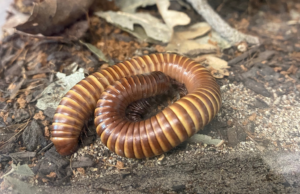Desert Millipede
Desert Millipede
Orthoporus ornatus
 As their name suggests, these beautiful, brightly-colored invertebrates are native to the Sonoran desert in southern California, where they spend much of their time burrowed in the soil or under rocks to avoid the dry heat. When threatened, these slow moving arthropods curl their bodies into a coil and release noxious fluids from glands on the tops of their legs, which can irritate the skin and eyes of potential predators.
As their name suggests, these beautiful, brightly-colored invertebrates are native to the Sonoran desert in southern California, where they spend much of their time burrowed in the soil or under rocks to avoid the dry heat. When threatened, these slow moving arthropods curl their bodies into a coil and release noxious fluids from glands on the tops of their legs, which can irritate the skin and eyes of potential predators.
Desert millipedes play a crucial role in their desert ecosystems, feeding on organic matter like dead plants, breaking that matter down as they digest it, and expelling the nutrients back into the soil where they become available to help new plants grow. In this way, millipedes act as decomposers, which are nature’s recycling system. Despite the irritating fluids they can release, desert millipedes are a food source for other desert species, like birds and rodents.
There are some common misconceptions about millipedes, including myths about how many legs they have. Despite the Latin prefix ‘milli’ (meaning 1,000) in their name, there is only one known species of millipede known to have over 1,000 legs. Millipedes are also often mistaken for centipedes, but unlike these carnivorous arthropods, millipedes are non-venomous. You can tell a millipede from a centipede by the millipede’s tube-shaped body with many segments, each of which sports two pairs of legs on the bottom of the body segment. Centipedes have flatter bodies with one pair of legs on the side of each body segment.
